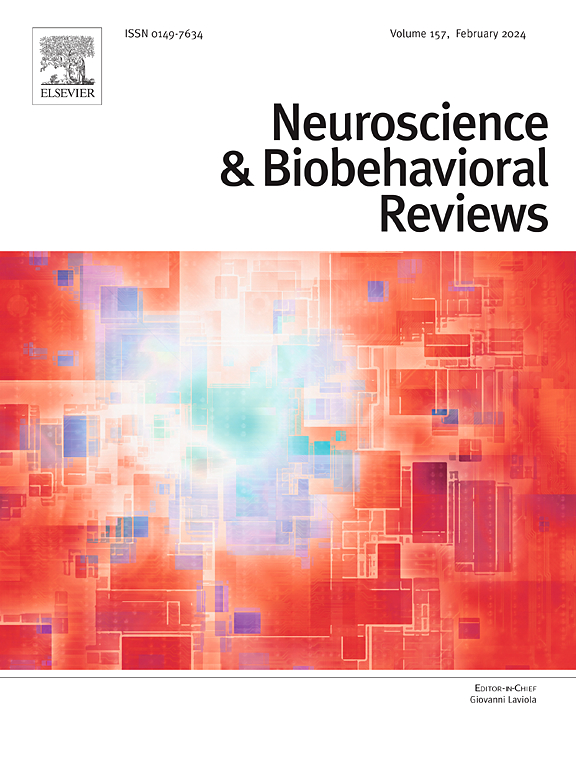Concerning the circadian rhythms of prolactin, its secretion timing, and regulation of the affiliative mind
IF 7.9
1区 医学
Q1 BEHAVIORAL SCIENCES
引用次数: 0
Abstract
Prolactin, traditionally regarded as a lactation hormone, is now understood to be a multifunctional modulator of physiology and behavior, integrating reproductive, metabolic, immune, and affective processes. A defining feature of prolactin is its circadian rhythmicity: in humans, levels peak during the early hours of the night—between 2:00 and 4:00 a.m.—a time closely aligned with caregiving, physical intimacy, and co-sleeping. This review synthesizes the neuroendocrine mechanisms underlying prolactin’s secretion, highlighting the roles of dopaminergic inhibition, hypothalamic signaling, photoperiodic input, and circadian regulation via the suprachiasmatic nucleus, alongside interactions with sleep–wake cycles. Beyond its well-established physiological roles, prolactin appears to attenuate activity in the hypothalamic-pituitary-adrenal axis, promote neural plasticity, and enhance social bonding in mothers and fathers, as well as in non-parental cooperative caregivers. Integrating these data, we propose that prolactin’s nocturnal rise may scaffold a circadian-gated neurobehavioral state – what we term the affiliative mind – characterized by calm affect, empathic attunement, and approach-oriented prosocial motivation. This state is potentiated by oxytocin and endorphin release during close social interactions, forming an amplifying feedback loop. As part of our general hypothesis, we also suggest that prolactin may influence higher-order social cognition through effects on the brain’s default mode network, and that its rhythms may become partially synchronized among individuals who cohabitate. Evolutionarily, prolactin’s nocturnal action may have transformed nighttime vulnerabilities into opportunities for solidifying trust and group cohesion. Together, plausible extensions of available data position prolactin as a chronobiological scaffold for affiliative behavior within and across individuals and social groups.
关于催乳素的昼夜节律,其分泌时间和附属心理的调节
催乳素,传统上被认为是一种泌乳激素,现在被认为是生理和行为的多功能调节剂,集生殖、代谢、免疫和情感过程于一体。催乳素的一个决定性特征是它的昼夜节律性:在人类中,催乳素水平在夜间凌晨2点到4点之间达到峰值,这段时间与照顾、身体亲密和共眠密切相关。这篇综述综合了催乳素分泌的神经内分泌机制,强调了多巴胺能抑制、下丘脑信号、光周期输入和通过视交叉上核的昼夜节律调节的作用,以及与睡眠-觉醒周期的相互作用。除了其公认的生理作用,催乳素似乎减弱下丘脑-垂体-肾上腺轴的活动,促进神经可塑性,并增强母亲和父亲以及非父母合作照顾者的社会联系。综合这些数据,我们提出,催乳素在夜间的上升可能会形成一种昼夜节律控制的神经行为状态——我们称之为附属心理——以平静的情感、共情调节和以接近为导向的亲社会动机为特征。在亲密的社交互动中,催产素和内啡肽的释放增强了这种状态,形成了一个放大的反馈循环。作为我们一般假设的一部分,我们还提出催乳素可能通过对大脑默认模式网络的影响来影响高阶社会认知,并且其节奏可能在同居的个体中部分同步。从进化的角度来看,催乳素在夜间的活动可能将夜间的脆弱转化为巩固信任和群体凝聚力的机会。总之,现有数据的合理扩展将催乳素定位为个体和社会群体内部和之间的从属行为的时间生物学支架。
本文章由计算机程序翻译,如有差异,请以英文原文为准。
求助全文
约1分钟内获得全文
求助全文
来源期刊
CiteScore
14.20
自引率
3.70%
发文量
466
审稿时长
6 months
期刊介绍:
The official journal of the International Behavioral Neuroscience Society publishes original and significant review articles that explore the intersection between neuroscience and the study of psychological processes and behavior. The journal also welcomes articles that primarily focus on psychological processes and behavior, as long as they have relevance to one or more areas of neuroscience.

 求助内容:
求助内容: 应助结果提醒方式:
应助结果提醒方式:


